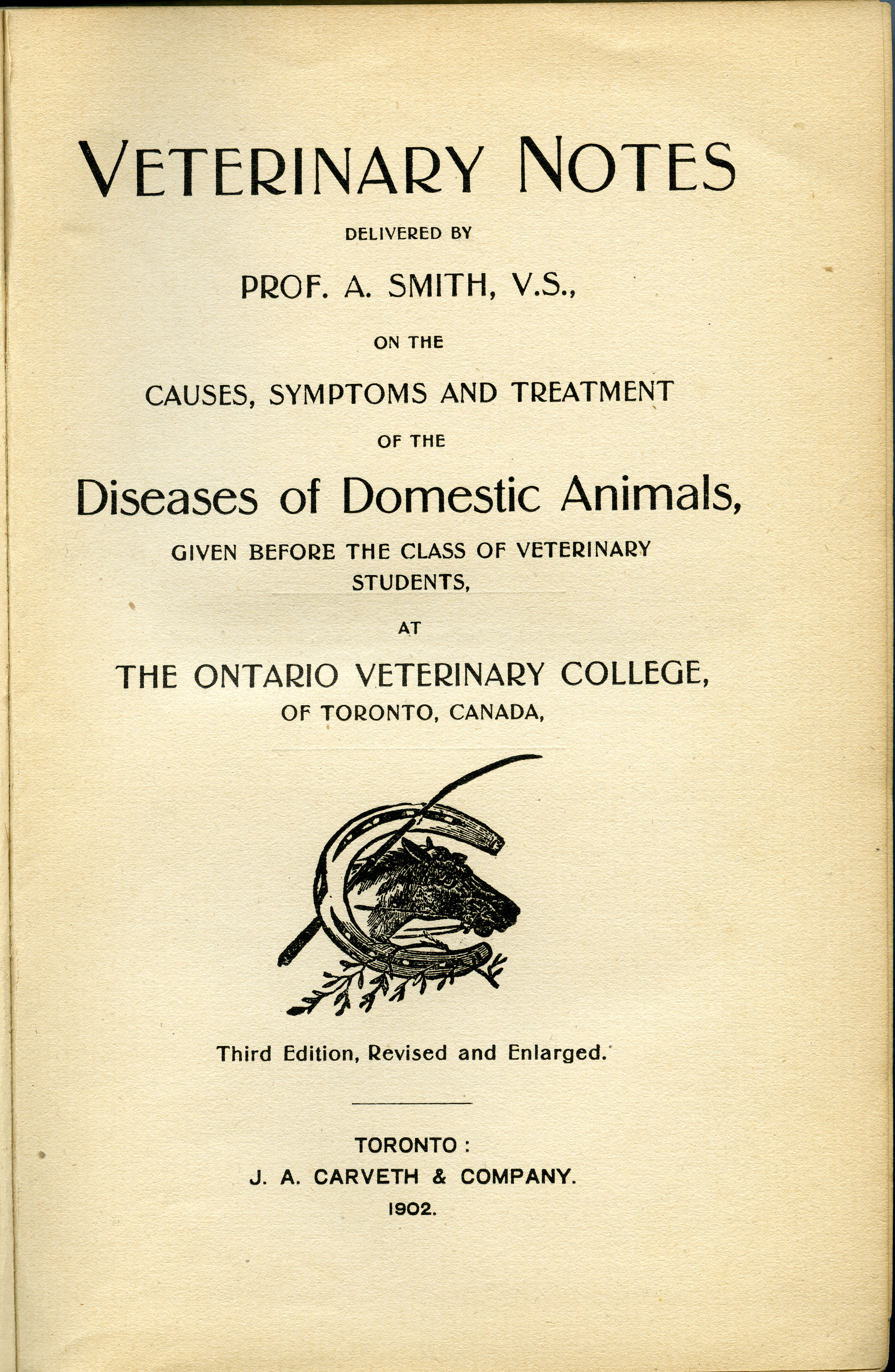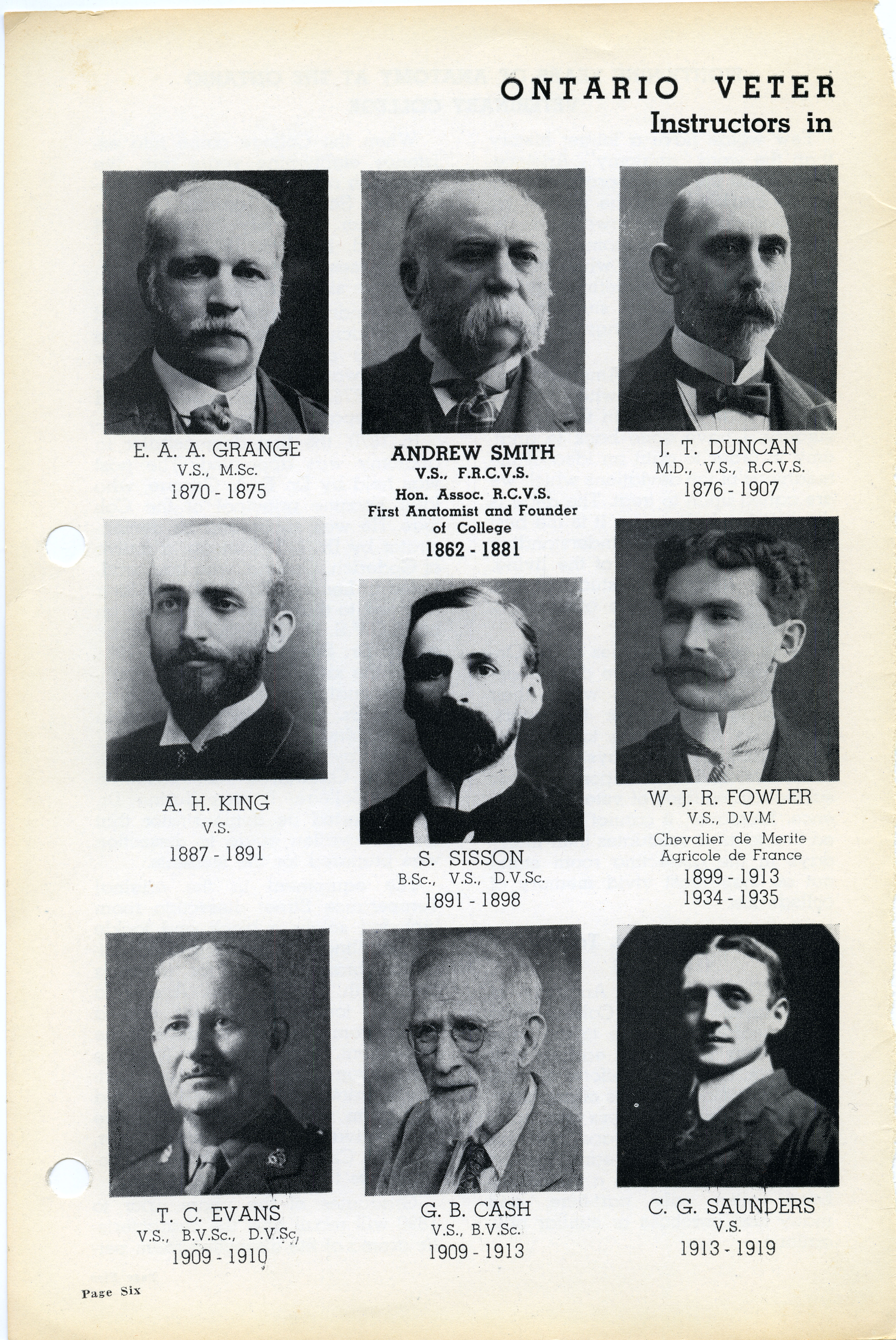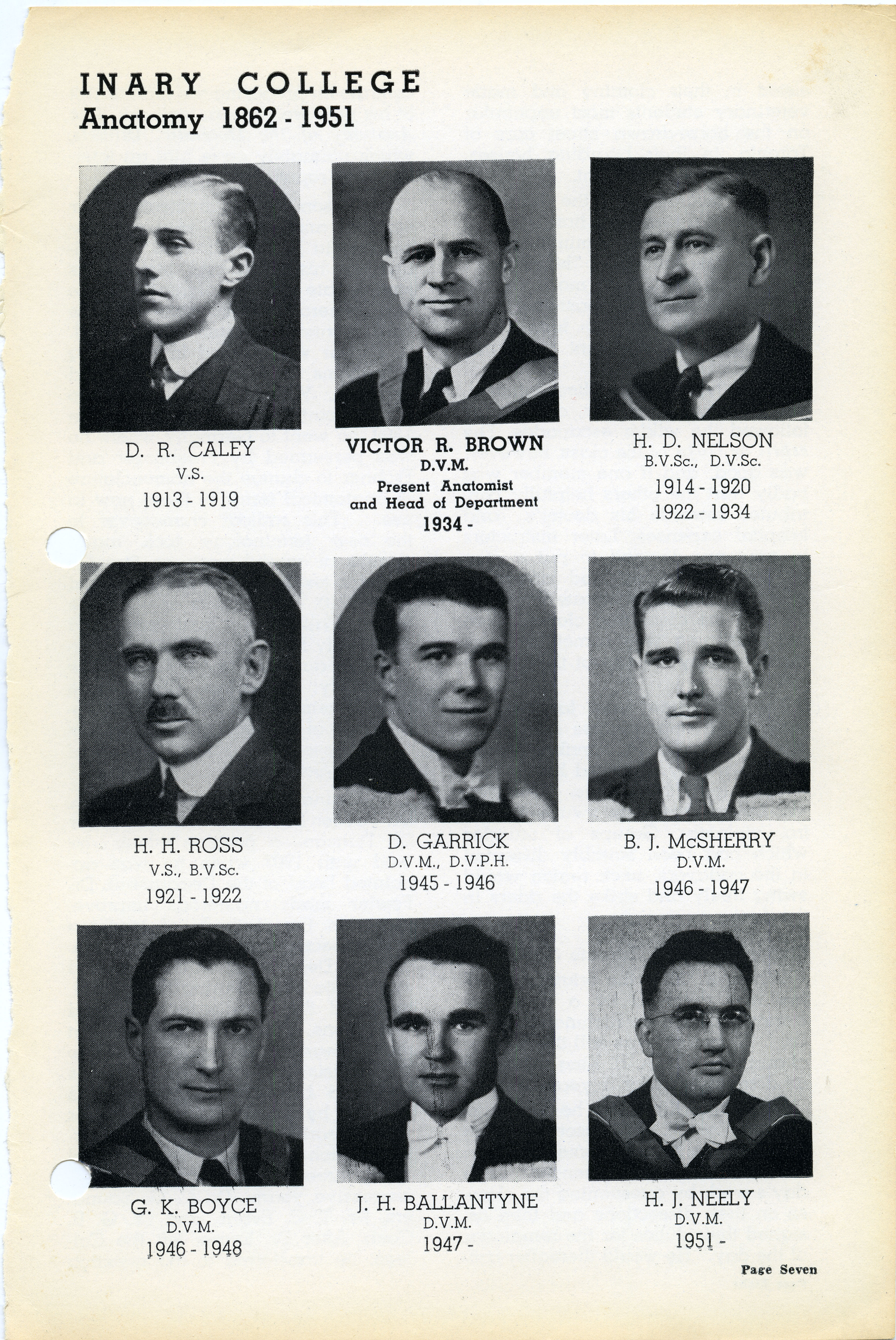Canadian Veterinary Education
The first continuously operating veterinary school in North America was founded in 1862 in Toronto, Canada, followed by the Montreal Veterinary College in Quebec, Canada in 1866. The two Canadian colleges, along with the European veterinary schools, supplied trained veterinarians and veterinary educators to the United States until veterinary education in America was established in the beginning of the 20th century. The Ontario Veterinary College (OVC) supplied almost 1600 veterinary graduates (more than any other veterinary college in North America) in the 19th century (Teigen & Blair, 1997, p. 65). Principals Andrew Smith (Toronto) and Duncan McEachran (Montreal) were rivals rather than collaborators with each espousing high educational standards for their programs and for their graduates. The OVC was established by Andrew Smith on a larger scale than any other veterinary school in North America. Students who chose the French-speaking Montreal Veterinary College may have been attracted by the reputations of McEachran and William Osler, the latter a preeminent medical researcher in North America. The British experience of veterinary education and educators was replayed in Canada. Referring to the early years of British veterinary education, Gardiner (2007, p. 307) commented, “… the result was an emergence of private, idiosyncratic colleges run by strong-minded individuals, with a tendency to compete rather than cooperate with each other.”
The two Canadian colleges, along with the European veterinary schools, supplied trained veterinarians and veterinary educators to the United States until veterinary education in America was established in the beginning of the 20th century.
Andrew Smith (1834-1910) and Duncan McEachran (1841-1924) brought with them the traditions of the Edinburgh school as they established veterinary education in two central provinces in Canada. In 1864, Andrew Smith was granted a charter to found a private veterinary school in Toronto, Canada called the Upper Canada Veterinary School, later to become the Ontario Veterinary College. He offered courses comparable to those in the Edinburgh school and was able to demonstrate the difference between the professionalism of his graduates and the trades of farrier and farmer in providing animal care. Smith began with a series of popular lectures that were compulsory for veterinary students, open to the public, and sponsored by the Canadian government's Board of Agriculture. The lectures were delivered from 1862 to 1870 and Smith was assisted by faculty from University College and selected medical lecturers. Unfortunately, Smith is recorded as saying that tuberculosis had a genetic origin, possibly because attitudes towards animal infectious diseases were changing rapidly in the 19th century. “By the end of the century [20th century] the causes of anthrax, tuberculosis, glanders, pyogenic lesions, pneumonia, brucellosis and tetanus – all common to man and animals – had been elucidated, whilst the discovery of the organisms of cholera, diphtheria, typhoid, gonorrhoea, cerebrospinal fever, plague, botulism and dysentery, had also reduced the toll of human suffering…” (Pugh, 1967, p. 131-132).
Smith was too busy establishing veterinary education in Canada to be a prolific author although he wrote Veterinary Notes on the Causes, Symptoms and Treatment of the Diseases of Domestic Animals, 1902, for his students. He co-authored a book with McEachran entitled The Canadian Horse and His Diseases, 1867, and an article entitled Treatment of the Late Epizootic Influenza or “Canadian Horse Distemper” on pages 85-95 of McClure’s Diseases of the Horse and Cattle and Sheep: Their Treatment : all found in the Rosen collection.



Duncan McNab McEachran (1841-1924) was a graduate of the Edinburgh school who had an important impact on Canadian veterinary education. McEachran was invited by Andrew Smith to assist in establishing the Upper Canada Veterinary School in Toronto and teach material medica. McEachran and Smith differed over teaching methods and McEachran relocated to Montreal to set up a private practice in 1866. Having received a grant of $300 and the support of some influential men from McGill College, McEachran established the Montreal Veterinary College in 1866. From 1866 to 1875 only ten students earned their diplomas. In 1877, McEachran set up the French-speaking part of the Montreal college with a curriculum identical to the English counterpart, except for the language of instruction. In 1889 the Montreal Veterinary College became the faculty of comparative medicine and veterinary science (a name suggested by Osler) of McGill University. McEachran was its first dean until 1903 when the faculty was forced to close. Low enrolments, lack of financial support, and competition for students from the Ontario Veterinary College were all factors in its demise. "Its [Montreal Veterinary College] pedagogical philosophy, which was based on the similarity between human and animal medicine, as well as on instruction in basic science combined with clinical experience, anticipated the teaching model that most Western schools of veterinary medicine would adopt after World War I" (Goulet & Jean, 2005-2019, Dictionary of Canadian Biography).
The Faculté de médecine vétérinaire at the Université de Montréal is the French-speaking college which arose from McEachran’s English-speaking one and has been in continuous operation since 1886 (Barker, 2013, Canadian Encyclopedia). In general, veterinary schools were located in cities with dense horse populations to afford students with varied clinical experience. Like Andrew Smith, Duncan McEachran maintained high educational standards for his college and subsidized the program with his own funds as government support was lacking.
At McGill University in 1874, McEachran met Dr. William Osler a leading medical educator. They collaborated to establish the comparative medicine and veterinary science faculty in 1890 and established the discipline of veterinary pathology as a foundation of veterinary education. When the veterinary school closed on McEachran's resignation, he took his ‘one health’ interest into government work as Chief Veterinary Inspector in Canada's Department of Agriculture from 1884 to 1902. He played a large part in developing infectious disease control legislation in Canada. In the Rosen collection is McEachran’s book, The Canadian Horse and His Diseases, 1867 co-authored with Andrew Smith.
Veterinary Education Introduction
European Veterinary Education
British Veterinary Education
North American Education
Veterinary Education in the United States
Return to Veterinary Education

